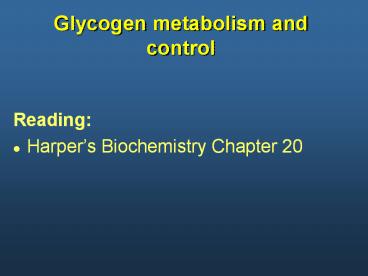Glycogen metabolism and control - PowerPoint PPT Presentation
1 / 22
Title: Glycogen metabolism and control
1
Glycogen metabolism and control
- Reading
- Harpers Biochemistry Chapter 20
2
OBJECTIVES
- To understand how glycogen is synthesized and
degraded in liver and muscle. - To understand how hormones like adrenalin and
glucagon affect glycogen synthesis and breakdown.
3
- Glycogen is the major storage form of
carbohydrate in animals and corresponds to starch
in plants. - Occurs mainly in liver and muscle.
4
Biomedical Importance
- Muscle glycogen acts as a convenient source of
hexose units for glycolysis within muscle itself.
Only depleted significantly after prolonged
vigorous exercise. - Liver glycogen is largely concerned with storage
and export of hexose units for maintenance of
blood glucose, particularly between meals. After
12-18h of fasting, the liver becomes nearly
depleted of glycogen. - Glycogen storage diseases are a group of
inherited disorders characterized by deficient
mobilization of glycogen or deposition of
abnormal forms of glycogen.
5
Glycogenesis- glycogen synthesis
- Occurs mainly in muscle and liver.
- Glucose is phosphorylated to glucose 6-phosphate
as in the first step of glycolysis. - Glucose-6-phosphate is converted to
glucose-1-phosphate by phosphoglucomutase. In
this reaction, the enzyme itself becomes
phosphorylated and glucose 1,6-bisphosphate is an
intermediate. - Glucose 6-phosphate Glucose 1-phosphate
- The key reaction in glycogen synthesis is the
formation of UDP-glucose by the action of
UDP-glucose pyrophosphorylase. - Glucose 1-phosphate UTP? UDP-glucose PPi
- This reaction proceeds to the right because PPi
is rapidly hydrolyzed to inorganic phosphate.
6
- Uridine diphosphate glucose (UDPGlc)
7
- UDP-glucose is the immediate donor of glucose
residues in the reaction catalyzed by glycogen
synthase, which promotes the transfer of the
glucose residue of UDP-glucose to a non-reducing
end of a branched glycogen molecule (primer must
have at least 8 glucose residues)
8
- Glycogen synthase cannot make the (?1?6) bonds
found at branch points of glycogen. This is done
by the glycogen-branching enzyme amylo (1?4) to
(1?6) transglycosylase. Branching makes
glycogen more soluble and provides more
non-reducing ends which act as sites for glycogen
synthase and glycogen phosphorylase
9
Initiation of a glycogen particle
- Because glycogen synthase requires a primer, a
new glycogen particle is formed by the protein
glycogenin (MV 37kD). - Glycogenin becomes glycosylated on a specific
tyrosine residue by UDP-glucose. Further glucose
molecules are attached in the 1? 4 position to
make a short glucose chain which can then act as
a primer for glycogen synthase.
10
Glycogenolysis- glycogen breakdown
- Glycogen can enter the glycolytic pathway as
glucose 6-phosphate following the action of two
enzymes glycogen phosphorylase and
phosphoglucomutase. - Glycogen phosphorylase releases terminal glucose
residues from the non-reducing end of glycogen
chains
11
Glycogen breakdown near a branch point
- This requires a debranching enzyme -
amylo(1?6)glucosidase - which has a transferase
and a glucosidase activity
12
- Glucose 1-phosphate, the end product of the
glycogen phosphorylase reaction, is converted to
glucose 6-phosphate by phosphoglucomutase - glucose 1-phosphate glucose 6-phosphate
- In liver (and kidney), but not in muscle, there
is a specific enzyme, glucose 6-phosphatase, that
removes phosphate from glucose 6-phosphate. The
glucose formed can diffuse from the cell into the
blood.
13
Cyclic AMP integrates the regulation of
glycogenolysis and glycogenesis
- The principle enzymes controlling glycogen
metabolism are glycogen phosphorylase and
glycogen synthase. - These enzymes are regulated by a complex series
of reactions involving both allosteric mechanisms
and covalent modification by phosphorylation/depho
sphorylation. - Glycogen phosphorylase is activated by
phosphorylation - Glycogen synthase is inactivated by
phosphorylation
14
Cyclic AMP activates muscle phosphorylase
- Epinephrine (adrenaline) activates the
?-adrenergic receptor on the surface of muscle
cells - This activates, via trimeric G proteins, the
enzyme adenylate cyclase, which makes cyclic AMP
from ATP - Cyclic AMP, or cAMP, activates cAMP-dependent
protein kinase (PKA) - R2C2 (inactive) 4cAMP R2-(AMP)4 2C
(active) - Active PKA phosphorylates and activates
phosphorylase b kinase - Active phosphorylase b kinase phosphorylates and
activates phosphorylase b, which can now mobilize
glycogen
15
(No Transcript)
16
Activation of phosphorylase kinase in muscle
- Phosphorylase kinase is also activated by Ca2
- Subunit structure (????)2
- ?,? - phosphorylated by PKA
- ? - catalytic subunit
- ? - calmodulin
- Calmodulin binds Ca2
- Binding of Ca2 by ? subunit enhances activity of
phosphorylase kinase - Therefore, Ca2 synchronizes the activation of
phosphorylase with muscle contraction
17
- Control of phosphorylase in muscle. The sequence
of reactions arranged as a cascade allows
amplification of the hormonal signal at each step
(n number of glucose residues G6P, glucose
6-phosphate).
18
Glycogen Synthase
- Glycogen synthase is also regulated by reversible
phosphorylation, but in this case, the
phosphorylated enzyme is inactive. - Glycogen synthase a - active form-
dephosphorylated - Glycogen synthase b - inacitve form-
phosphorylated
19
- In muscle, when PKA is active and glycogenolysis
is promoted, glycogen synthase is maintained
inactive by the same pathway
20
(No Transcript)
21
SUMMARY
- 1. Glycogen represents the principal storage
form of carbohydrate in the mammalian body,
present mainly in the liver and muscle. - 2. In the liver, its major function is to
service the other tissues via formation of blood
glucose. In muscle, it serves the needs of that
organ only, as a ready source of metabolic fuel. - 3. Glycogen is synthesized from glucose and
other precursors by the pathway of glycogenesis.
It is broken down by a separate pathway known as
glycogenolysis. Glucose is not exported from
muscle due to absence of glucose 6-phosphatase.
22
SUMMARY
- 4. Cyclic AMP integrates the regulation of
glycogenolysis and glycogenesis by promoting the
simultaneous activation of phosphorylase and
inhibition of glycogen synthase. Insulin acts
reciprocally by inhibiting glycogenolysis and
stimulating glycogenesis. - 5. Inherited deficiencies in specific enzymes of
glycogen metabolism in both liver and muscle are
the causes of glycogen storage diseases.































